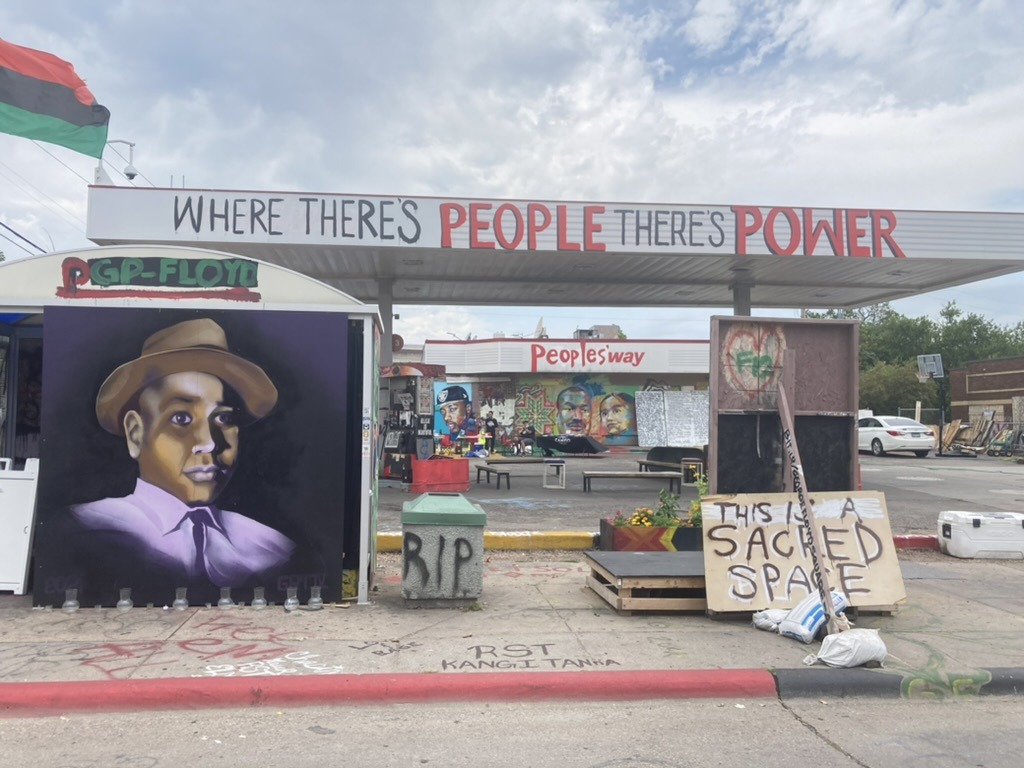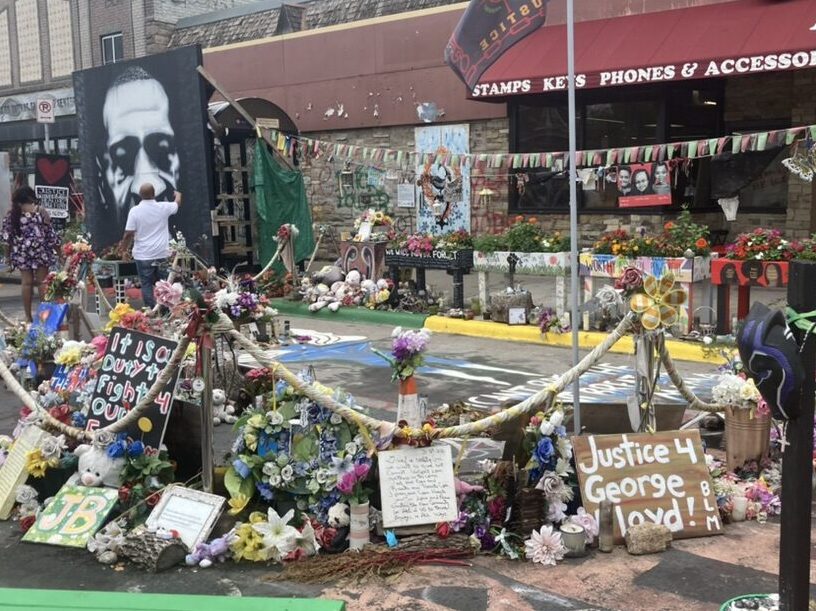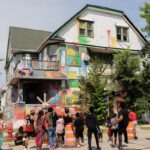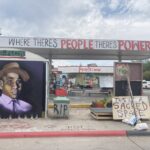Building Resistance: Introductory Remarks
Laura Thompson
May 23, 2023
Three years ago, George Floyd was murdered at 38th and Chicago on the south side of Minneapolis. The intersection, now known as George Floyd Square (GFS), endures as a living memorial, not only for Floyd, but for the many other victims of police violence including Philando Castile and Jamar Clark. The entrance of GFS is marked by a large metal fist raised toward the sky, clearly invoking political solidarity with the Black Power movement. The square itself is teeming with text, murals, music, and conversation. Visual productions range from planned murals to urgent sharpie messages pleading for justice. GFS continues to be an active site, central to community organizing, projects, and remembrance—a site that is protected and cared for.

Three years ago, many of the protests that erupted over the summer of 2020 gathered under the banner of Black Lives Matter, a decentralized political and social movement founded in 2013 by Patrisse Cullors, Alicia Garza, and Ayọ (formerly Opal) Tometi. It was formed in response to George Zimmerman’s acquittal in the 2012 murder trial of Trayvon Martin. Mobilized by the Twitter hashtag #BlackLivesMatter, the movement expanded rapidly in 2014 in response to the deaths of Michael Brown and Eric Garner, prompting protests, like the choreographed “Hands Up, Don’t Shoot” marches aimed at drawing attention to and condemning racist acts of police brutality. Over the past decade, the Black Lives Matter movement has continued to grow through its non-hierarchical configuration, reaching levels of engagement in 2020 unseen previously in American history.[1]

Systemic racism has long persisted in the United States. While discrimination is a part of many—if not all—social and political institutions, racial bias within the criminal justice system is particularly devastating on an individual, familial, communal, and national level. This is not a new development, but an ongoing problem. The increased visual documentation of police brutality is a consequence of the interlocking developments of social media and smart phones. For Nicholas Mirzoeff, Black Lives Matter formations produce a decolonial space of appearance that challenges neoliberal and white supremacist infrastructures. Working within the intellectual discourse of the public sphere, Mirzoeff draws on Hannah Arendt’s concept of the “space of appearance” in which speech and action are contingent upon the presence of other human beings. Her characterization of the space of appearance is tethered to Jürgen Habermas’s notion of the public sphere and relies on the purposeful organization of people acting and speaking together. Arendt states, “alienation is [the] atrophy of the space of appearance and the withering of common sense.”[2] While Arendt believed that the space of appearance was accessible or formable only through physical togetherness, Mirzoeff extends it to the realm of the digital. He argues that in the contemporary period, technologies like smart phones and social media can be used to counteract previous spaces of nonappearance, which he describes as “the racialized counterpart to the ‘nonplaces’ of consumer society, designated white … located between private and corporate property, the space of nonappearance has become a featureless killing zone.”[3] Mirzoeff comprehends this space of precarity to be where many have been fatally shot by police.
Significantly, social media has not only become a public where police brutality is exposed. It has also become a site for visualizing and disseminating digital images and videos of activist actions. For example, Black Lives Matter activists have staged many significant happenings including mass die-ins, the act of turning one’s back to the police, and defiantly meeting the gaze of police. By turning their backs on the police, the protesters signal that they do not recognize the authority of the police and by extension the nation-state itself due to its failure of protecting and serving all people. Importantly, each of these physical activisms have been made possible through social media organizing, which has enabled swift collective actions. In addition, the actions themselves have been bolstered through social media. By broadcasting the right to look through social media, activists push back against mainstream narratives that depict police as unimpeachable. As Judith Butler suggests, an ontological shift is necessary to bring forth real change in how life is valued.[4] While the current socio-political model seems to be the only possible system, it is important to remember that this structure and valuing system is just one of many. In an era wherein the visual image has become a primary form of absorbing information, it is vital that individuals continue to use their own right to look and produce counter-visuals that support other perspectives on events. By denaturalizing the nation-state’s narrative through the visual, we can erode how bodies are valued and reconsider our systems of (dis)engagement.
This issue of FIELD centers on artists, activists, and organizations that engage with or draw on some of the principles and concerns of the Black Lives Matter movement. The interviews and essays that compose our Spring issue developed out of conversations over the past couple of years between FIELD collective members and contributors including Bria Dinkins, Primrose Paul, and Laura Thompson. We began by thinking about how graffiti, mural-making, movement, and protest were being represented in both mainstream and social media, and how these developing visualizations informed the discourse surrounding the 2020 demonstrations. Further, we opted to think about how BLM has intersected with issues pertaining to housing, preservation, collective production, craft, public monuments, and the art market as a means to meditate on the far-reaching impact of this social-political movement.
Included in this issue are three essays and four interviews, two of which were conducted with Minneapolis-based organizations: the Million Artist Movement (MAM) and Memorialize the Movement (MTM). Both groups formed in direct reaction to police violence and grassroots demonstrations. MAM was established in 2014 in response to Michael Brown’s death and the Ferguson protests out of a desire to create a space for processing grief, expressing one’s thoughts through art-making, and having conversations. While MAM has many facets, an important one is the quilt-making workshop—the final products of which have been given to grieving families in an act to extend communal comfort. Similarly, Leesa Kelly formed MTM in the wake of George Floyd’s murder when she recognized the importance of salvaging and preserving the murals and graffiti painted on protest boards during the 2020 summer uprisings. Through these acts of conservation, histories of the many are preserved, and in this way they resist erasure. In Los Angeles, Shamell Bell developed Street Dance Activism while being a leader in the Black Lives Matter protests and a core organizer with Justice 4 Trayvon Martin. For Bell, the embodied language of protest can be lived through the collective act of dance; a means to joyfully express resistance and discontent. In Milwaukee, HomeWorks: Bronzeville was formed by Mikal Floyd-Pruitt, Vedale Hill, and Sara Daleiden in a desire to combat the gentrification of a historically black neighborhood and to cultivate community through the arts.
In addition to these interviews, we are also including several essays, each of which grapple with contemporary complexities of race, protest, and representation. In “The Promise it Makes: Art and the Afro-futuristic Future,” Primrose Paul critiques the cultural marketplace and the commodification of black visual art. Drawing on the framework of Afrofuturism, Paul examines the artwork of Omoruyi Eghosa, Emmanuel Massillon, and Sam Onche as a means to push back against prevalent narratives of black art and creativity. In doing so, Paul critiques the exploitation of cultural essentialism and the perpetuation of one-dimensional stereotypes. Drawing on Herbert Marcuse, she suggests that “the black artist must work within the confines of capitalism by aligning themselves with Afrofuturism.”[5] In this way, she envisions a potential future in which society is not ruled through domination, but rather connection and mutual respect.
Reflecting on the re-negotiated meaning of confederate statues during the 2020 BLM protests, Bria Dinkins explores how the signification of these monuments shifts through the additions of graffiti, protest, and other forms of visualized discontent. Dinkins’s essay, “Monumentality, Media, and Rhetoric Surrounding Protest” analyzes how mainstream responses to what she calls “monumental interventions” invoke the shrouded rhetoric of systemic racism in the United States, including allusions to “law & order” and respectability politics.
Recalling Mirzoeff’s discussion of the decolonial space of appearance, Bellara Huang considers how social media has provided space for grassroots resistance, both in terms of expressing discontent in the digital sphere as well as rapidly organizing in-person gatherings and protests. Focusing on Almagul Menlibayeva’s artistic collaborations with AI to compose representations of Kazakhstan’s Bloody January—a series of mass protests against the state in 2022—Huang explores how violence and protest can be visually represented without exploiting the pain of the victim(s). Huang also emphasizes how Menlibayeva deconstructs the feigned objectivity of photography in journalism. This recalls Dinkins’s reflection on mainstream media’s manipulation of public perception based on which image they select to represent an individual. She writes, “Martin was effectively blamed for his own death because experts asserted that his hoodie—rather than his Blackness— ‘marked him as a ‘gangsta.’ People responded to this line of argumentation on social media by posting photographs of themselves wearing hoodies.”[6]
While these essays and interviews may seem disparate, the common theme of forming a counter-public or counter-visuality emerges from this collection. It bespeaks a common resistance against overarching narratives that have long saturated society, especially in the United States—a nation that in many ways has been founded upon and defined by difference. In this way, we can recall bell hooks’ observation that the margin can indeed be a site to gather, a site of strength, a site of resistance.[7] It is our view that each of the artists, activists, and organizations spoken with and written about are doing just that—building resistance.
Laura Thompson is a Ph.D. student in Art History, Theory, and Criticism at the University of California, San Diego and a member of FIELD’s editorial collective.
Notes:
[1] Larry Buchanan, Quoctrung Bui, and Jugal K. Patel, “Black Lives Matter May Be the Largest Movement in U.S. History,” New York Times (July 3, 2020), https://www.nytimes.com/interactive/2020/07/03/us/george-floyd-protests-crowd-size.html.
[2] Hannah Arendt, The Human Condition (Chicago: University of Chicago, 1998), p. 209.
[3] Nicholas Mirzoeff, The Appearance of Black Lives Matter (Name Publishers, 2017), p. 118.
[4] Judith Butler, Frame of War: When if Life Grievable? (London: Verso, 2009).
[5] Primrose Paul, “The Promise it Makes: Art and the Afrofuturistic Future,” FIELD: A Journal of Socially Engaged Art Criticism (Spring 2023), http://stagetemple.field-journal.com/?p=7122.
[6] Bria Dinkins, “Monumentality, Media, and the Rhetoric Surrounding Protest,” FIELD: A Journal of Socially Engaged Art Criticism (Spring 2023), http://stagetemple.field-journal.com/?p=7121
[7] bell hooks, “Marginality as a Site of Resistance,” Out there: Marginalization and Contemporary Cultures, Vol. 4. (Cambridge, Mass; New York, N.Y: New Museum of Contemporary Art, 1990), 341-343.







